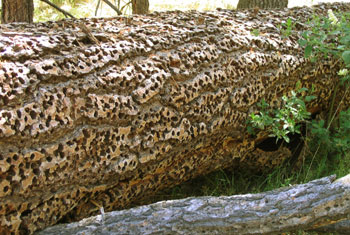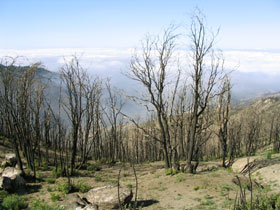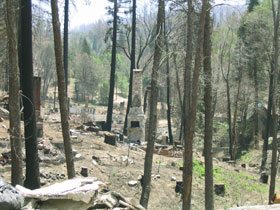Healthy Forests Fire Up
Air Date: Week of May 21, 2004
Wildfire season has come early to parts of the American West and some in Congress complain the Bush administration is ill-prepared to fight or prevent fires, despite the promises of the President's healthy forests initiative. Jeff Young reports from Washington while Ingrid Lobet has a look at what's happening in the fire-prone forests of Southern California.
Transcript
CURWOOD: It’s Living on Earth. I’m Steve Curwood.
Like the Christmas shopping season, wildfire season seems to come a little earlier each year in the American west. California and Arizona have already seen fires and the forecast for much of the interior west shows an elevated risk for fire this summer.
Last year’s devastating blazes in southern California pushed Congress to act on the Bush administration’s controversial plan to thin trees to reduce the risk of fire—a plan called “Healthy Forests.” As the healthy forests program takes shape it’s also generating healthy debate in communities near national forests and in the halls of Congress.
We’ll have two reports, one from California where forest thinning to protect homes against wildfires is underway. But we start in Washington, D.C. where some lawmakers are questioning the administration’s readiness for what looks like another tough fire season. Living on Earth’s Jeff Young has our report.
MAN: Subcommittee is meeting today to hear testimony on firefighting preparedness. Are we ready for 2004 fire season?
YOUNG: After years of patching together emergency funds to pay billion dollar bills for fighting forest fires, Congress is taking a hard look at the Bush administration’s preparation for this fire season. So far they don’t like much of what they see.
INSLEE: Rome burned while Nero fiddled, and I believe this year we’re going to have our forests burning because the government has fiddled and not become adequately prepared for what will be a major fire season.
YOUNG: Washington Democratic Representative Jay Inslee summed up the concerns of many lawmakers, as Forest Service and Agriculture department officials took fire from both houses and both parties. Lawmakers say the agencies have again underestimated what they’ll need to fight fires, and will have to drain money from other important programs to cover the costs. That’s something New Mexico Republican Senator Pete Domenici would rather avoid.
DOMENICI: Are we making a mistake in not putting enough in? Are you giving us the wrong estimates? Or just why do we have to continually borrow from Peter to pay Paul?
YOUNG: Lawmakers say programs designed to prevent fires are losing out. The administration’s budget proposal cuts a popular program called Firewise, which helps homeowners reduce fire risk. Spending on surveys to find the insect and disease damaged trees that can easily catch fire is also down. And California Democratic Senator Diane Feinstein complains of a 40 percent cut in assistance for state and local fire prevention efforts.
FEINSTEIN: That’s a dramatic cut. I’m hearing from fire safe councils all throughout the state with real concern.
YOUNG: But the harshest criticism was leveled at the administration’s new Healthy Forests Initiative, and some of it came from the administration’s supporters. Wyoming Republican Senator Craig Thomas pressed assistant Agriculture secretary Mark Rey for details on what’s been done to reduce the dead and damaged trees.
REY: What’s happened is we hit an all-time record of 2.6 million acres treated last year. That’s the most --
THOMAS: Treated? What do you mean treated?
RAY: Thinned, fuel reduced.
THOMAS: Where?
RAY: Throughout the country, including some in Wyoming. I’ll take you out and show you some in Wyoming.
THOMAS: I’ll take you out and show you some where there’s tons of beetle kill that’s never been touched. I’ll take you to the Shoshone and they have a plan that’s never been implemented.
YOUNG: Rey told Thomas it takes time to implement a new program, find workers, and overcome general bureaucratic inertia. He says nearly three million acres will be thinned this year, but the ultimate goal of 80 to 90 million acres could take more than a decade.
REY: But realistically that’s what it’s gonna take, eight to 12 years. It took us one hundred years to get into this situation and we’re not going to get out of it overnight.
YOUNG: Still, the slow rate of work infuriates the Senate Democrats who broke ranks with their party in the midst of last fall’s fires to vote for the President’s initiative. Ron Wyden of Oregon says the administration’s spending does not live up to promises in the bill.
WYDEN: You all are taking the health out of the healthy forests program! I think that there is going to be enormous frustration out in rural America which is expecting these new funds to get the important work done. And you all are basically doing a bait and switch!
CURWOOD: As lawmakers on Capitol Hill haggle over healthy forest spending, we took a look at how that money is being put to use in the places the policy is supposed to protect. Living on Earth’s Ingrid Lobet visited one fire-prone region in Southern California and found the fuel reduction program in full swing in the San Bernardino National Forest.
[BIRDS CALLS]
LOBET: The alpine towns of Southern California's San Bernardino mountains were already adapting to change. Older pine cabins for fishing and skiing -- and a few thousand year-round residents --- had been making room for K-Mart and car rentals as newcomers swelled the towns that now push up against the national forest.
[BELLS AND MACHINE GRUMBLE OF CHIP GRINDER]
LOBET: These days many of the newcomers are loggers who almost overnight have turned this from a logging-free zone into a timber festival. Captain Steve Faris of the California Department of Forestry and Fire Protection looks down with awe on a 15-acre stretch of log piles.
FARIS: We've identified over 137 contractors working in the mountains here. I think this site represents about 25 of them. Every state in the union has people here.
LOBET: One hundred thirty-seven contractors, 600-plus trees coming down every day. Hundreds of tons of limbs and logs moving through this makeshift mill site. It's all part of a massive push to cut down dead trees in a forest turned brown with stress.
[SAWING SOUNDS UP AND UNDER]
FARIS: Yes, all that you see here represents dead, dying and diseased trees off of public and private lands. That's all we're taking out at this time.
LOBET: The forests here are starving for water after six straight years of drought. They've grown in too close together, foresters say, and so they compete for sparse rain. Some say air pollution also weakens the trees. Then, bark beetles finish them off. Faris shows me a piece of bark.
 Woodpeckers take advantage of the holes first excavated by bark beetles (Photo: Ingrid Lobet)
Woodpeckers take advantage of the holes first excavated by bark beetles (Photo: Ingrid Lobet)
FARIS: Right here you see the remains of a pitch tube. This is where the tree attempted to push the bark beetle out by pushing pitch out the hole where the bark beetle was attempting to come in. Normally they can do that fairly well, but the population is so high now that even the most healthy trees are being overwhelmed by the numbers of bark beetles that attack it.
YOUNG: Mountain residents say they've been pleading for help with the dead trees for several years. They see the dead needles as gunpowder awaiting a spark. Then, the spark came. After last fall's disastrous fires turned about 3,500 homes into ash, the congressional spigot opened wide. Two hundred and sixty million dollars is now flowing to Southern California, an amount other drought-stricken regions can scarcely imagine. For foresters like Steve Faris, the money means headway.
FARIS: We've taken out a huge number of trees. We're not keeping up with the mortality rate from the bark beetle, but we're starting to catch up and we're seeing a lot of good results.
LOBET: Making the 180 degree turn from no tree-cutting to full-bore tree removal has been hard on mountain residents of every stripe, says Laura Dyberg.
[SOUND OF MOVING CAR]
DYBERG: A lot of people's attitudes are similar to what mine was back in 1997, when I came out of a movie theater and saw my entire mountain on fire. There's huge mushroom clouds of smoke, black, white, and flames that could be seen. My reaction was not worry about my friends, my family, my home, my pets. My initial concern was, if I was going to have to take the long way to get home. But that was my reaction. And the reason was is our fire agencies do their job. They put fires out! And I think, unfortunately, that is a very prevalent attitude in mountain communities and rural communities. We rely on these heroes to do their job, and it never occurs to us that sometimes it’s beyond them. That's a hard thing. The fire engine will not be in your driveway. You know, the air tanker will not be dropping fire retardant on your house.
LOBET: So now, as a local director of a fire safe council, Dyberg plays evangelist -- cajoling people to move cordwood off their porches, take down trees as soon as the beetles get them, and relinquish long-held views about architectural preservation.
DYBERG: At one point they even required shingled roofs because of the aesthetic -- again, the mountain environment.
LOBET: Just then a man in a hardhat waves us to a stop.
DYBERG: We’re coming up on a tree cutting operation, it would appear.
LOBET: This is just something that happens every single day.
DYBERG: Every single day. Now I might be stopped three or four times for logging trucks pulling on the highways, actual crane -- there goes part of a logging trip – crane operations.
|
|
DYBERG: Two years ago you couldn't see half these houses, because the trees were so dense. People have seen neighbors now that they didn't know they had. LOBET: Dyberg turns down a narrow road and into a former neighborhood now carpeted with ash. [SLAMMED CAR DOOR, FOOTSTEPS EXITING CAR] LOBET: Piles of burnt box-springs and exploded propane tanks line the road. [CLINKING OF EMPTY METAL TANKS] LOBET: This was Cedar Glen, a tightly packed community of homes in the middle of the woods and the county doesn't want it rebuilt.
[KNOCK ON DOOR, BRUSHED WIND CHIMES, FOOTFALLS] HENYON: There's my iris coming up! LOBET: Shannon Henyon steps down from a new trailer. She is one of the few former residents who still lives here. What she wants you to know about her is that she's an artist and a Christian. And what you notice is her lack of self-pity, though she's recently lost her husband and her father, and all her tools burned in the fire.
LOBET: Henyon blames the fire that destroyed her home on the forest service for not thinning nearby, and on county officials who she says discouraged neighbors from cutting trees. HENYON: I'm going to rebuild. I don't care what they say. They could declare it eminent domain and take it from me. And I won’t leave if they do. They’re going to have to drag me off. This is my home, and I brought up my children here, I raised my family here. This is where I belong. LOBET: As Henyon augers for a fight, trees are falling outside communities in the surrounding forest. Forest Service Manager Mike Dietrich says he can clear 200-foot-wide swaths of fire buffer now without any protests from environmentalists. No more burning forest service officials in effigy. But he's exhausted, and so is everyone else he knows. DIETRICH: We're all, to use the expression, busier than a one-handed paperhanger. It's just been incredible. Six days a week, actually some of us seven days a week. LOBET: The Bush administration's Healthly Forests policy is helping move things along too, he says, because it allows him to go forward with thinning projects with no chance of an environmental appeal. But finding qualified workers in the numbers he now needs has been rough. DIETRICH: It's been very difficult, to say the least, ramping up for this. Because you don't go from zero to 90 overnight. The money that Congress has allocated has been very generous. I’d like to be going faster. LOBET: For once, it seems, most everyone in this part of California can agree on what's needed to bring aid to a sick forest. The weather could still outrun them, still, they have the funds to make a go of it. But, my colleague Jeff Young has been talking to people elsewhere in the nation who say federal dollars that are supposed to prevent fires are not helping their communities. YOUNG: Sharon Galbreath usually sees forest issues from a green point of view—she directs the Arizona environmental group Souwthwest Forest Alliance. But when she looks at what’s happening in Southern California’s forests it is with the green eye of envy. Galbreath says she’d like to see such well-funded fuel thinning projects underway close to Arizona’s homes and communities. Instead, she fears a repeat of what happened in Summerhaven, Arizona last year. GALBREATH: The community of Summerhaven was so desperate for funds to thin the forest around their community that they took the unusual step of actually petitioning the government to release close to one million dollars that would have been necessary to adequately thin the forest around their community on Mount Lemon. Instead, the forest service ended up with $170,00 that summer, which was too little too late as it turned out. YOUNG: Too late because last June much of Summerhaven burned, along with some 85,000 acres of forest. Galbreath says while the forest service found little money to thin the trees around Summerhaven, it had no trouble funding a timber sale in a patch of old growth forest near the Grand Canyon. GALBREATH: Yeah, the stated purpose for the East Rim project is forest health and fire reduction --even though the nearest community is 48 miles away. YOUNG: Administration’s critics say that’s the main problem with Healthy Forests. Too much money is spent on projects too far from homes. Michael Francis heads the national forest program for the Washington-based Wilderness Society. Francis says scientists know that thinning in what’s called the wildland/urban interface – the area where homes border forests -- can dramatically improve a home’s chances in a fire. FRANCIS: And the closer in the better. Right now the fire science tells us that within a quarter to a half a mile of a community, that that type of work will offer a 90 percent better chance of protecting those communities – people’s homes, protecting their lives, and protecting their communities. Going outside that half- to quarter-mile zone around a community we’re experimenting here. We ought to take it slow. It should be driven by science. YOUNG: The Healthy Forests Act requires only half the thinning projects to take place near homes. Assistant Agriculture Secretary Mark Rey says some of the thinning work needs to happen in remote areas. REY: Over 60 percent of the work is being done in wildland/urban interface. But we’ve also said that’s not the only area we want to treat, that there are other priorities like municipal watersheds or other areas where we have ecologically-sensitive resources we’re trying to protect. YOUNG: But the wilderness society’s Francis sees another motive. FRANCIS: My guess is that they’re doing it because of timber industry. The forest service sees that there are a lot of big trees out there that the industry wants. They’re economic and profitable trees. That way they can get out there and do that work and reward their friends in the timber industry. YOUNG: The administration’s budget, which cuts spending for fire prevention and suppression, increases spending for the forest service to carry out timber sales. For Living on Earth, I’m Jeff Young in Washington. CURWOOD: You can see maps showing the nation’s fire forecast and read tips on how to protect your home from wildfire on our Web site, livingonearth.org. [MUSIC] Links
|








